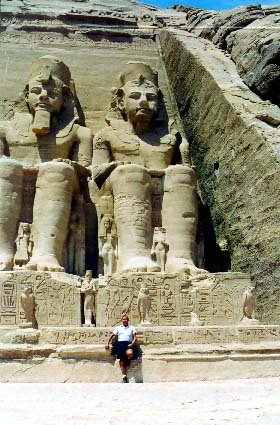 monuments in the world but their removal and reconstruction was an
historic event in itself.
monuments in the world but their removal and reconstruction was an
historic event in itself.
History of Abu Simbel
Here I am in front of the giant statues of Ramses II in the Nubian Desert.
Not only are the two temples at Abu Simbel among the most magnificent
 monuments in the world but their removal and reconstruction was an
historic event in itself.
monuments in the world but their removal and reconstruction was an
historic event in itself.
When the temples (280 km from Aswan) were threatened by submersion in Lake Nasser, due to the construction of the High Dam, the Egyptian Government secured the support of UNESCO and launched a world-wide appeal. During the salvage operation, which began in 1964 and continued until 1968, the two temples were dismantled and raised over 60m. up the sandstone cliff where they had been built more than 3,000 years before.
Here they were reassembled, in the same relationship to each other, and covered with an artificial mountain. Most of the joins in the stone have now been filled by antiquity experts, but inside the temples it is still possible to see where the blocks were cut.
You can also go inside the man-made dome and see an exhibition of photographs showing the different stages of the massive removal project. The design of Abu Simbel is unique - rock-hewn "grotto" temples, although unusual in Egypt, are frequently found in Nubia, but there is no other example of twin sanctuaries, in this case dedicated to Ramses himself and to his wife Nefertari, which combine to form a single ensemble.
Unlike all the other Nubian temples Abu Simbel was never transformed into a church but was left alone, untouched by later religions, until it was recovered from the sand in 1817. The image of the main temple facade, with its four colossi and row of grinning baboons, is well-known all over the world but its immense power and majesty are impossible to depict visually.
Even today you can still feel the full might of the pharaoh-god in this edifice dedicated to masculine prowess and military power and, equally, the love of his wife and children, symbolized in the flowers and femininity of the smaller temple. Superb relief's detail the Battle of Kadesh, and Ramses and Nefertari consorting with the deities and performing religious rituals. And the rays of the sun still penetrate to the Holy of Holies deep in the rock of the main temple on the same two days of the year: the 20th of October and the 20th February. This timing is probably connected to the symbolic unification, via the rays of the sun, of the statue of Ra-Herakhty and the statue of Ramses ll.